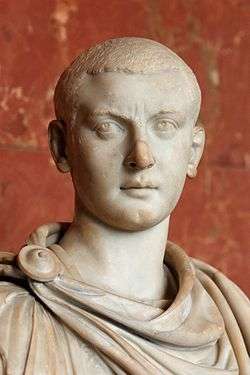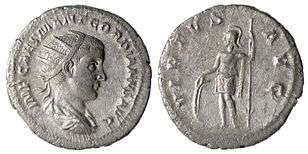Gordian III
Gordian III (Latin: Marcus Antonius Gordianus; 20 January 225 – 11 February 244 AD) was Roman emperor from AD 238 to 244. At the age of 13, he became the youngest sole legal Roman emperor throughout the existence of the united Roman Empire. Gordian was the son of Antonia Gordiana and an unknown Roman Senator who died before 238. Antonia Gordiana was the daughter of Emperor Gordian I and younger sister of Emperor Gordian II. Very little is known of his early life before his acclamation. Gordian had assumed the name of his maternal grandfather in 238 AD.
| Gordian III | |||||||||
|---|---|---|---|---|---|---|---|---|---|
 Bust of Gordian III, between 242 and 244 | |||||||||
| Roman emperor | |||||||||
| Augustus | 29 July 238 – 11 February 244 (nominally, though government done by senate) | ||||||||
| Predecessor | Pupienus and Balbinus | ||||||||
| Successor | Philip the Arab | ||||||||
| Caesar | 22 April – 29 July 238, subordinate to Pupienus and Balbinus | ||||||||
| Born | 20 January 225 | ||||||||
| Died | 11 February 244 (aged 19) Zaitha | ||||||||
| Spouse | Furia Sabinia Tranquillina | ||||||||
| |||||||||
| Dynasty | Gordian | ||||||||
| Father | Junius Balbus | ||||||||
| Mother | Antonia Gordiana | ||||||||
Rise to power

In 235, following the murder of Emperor Alexander Severus in Moguntiacum (modern Mainz), the capital of the Roman province Germania Superior, Maximinus Thrax was acclaimed Emperor. In the following years, there was a growing opposition against Maximinus in the Roman senate and amongst the majority of the population of Rome. In 238 a rebellion broke out in the Africa Province, where Gordian's grandfather and uncle, Gordian I and II, were proclaimed joint emperors. This revolt was suppressed within a month by Cappellianus, governor of Numidia and a loyal supporter of Maximinus Thrax. The elder Gordians died, but public opinion cherished their memory as peace-loving and literate men, victims of Maximinus' oppression.
Meanwhile, Maximinus was on the verge of marching on Rome and the Senate elected Pupienus and Balbinus as joint emperors. These senators were not popular men and the population of Rome was still shocked by the elder Gordians' fate, so the Senate decided to take the teenage Gordian, rename him Marcus Antonius Gordianus like his grandfather, and raise him to the rank of Caesar and imperial heir.[2] Pupienus and Balbinus defeated Maximinus, mainly due to the defection of several legions, particularly the II Parthica, who assassinated Maximinus. However, their joint reign was doomed from the start with popular riots, military discontent and an enormous fire that consumed Rome in June 238. On July 29, Pupienus and Balbinus were killed by the Praetorian Guard and Gordian proclaimed sole emperor.
Reign

Due to Gordian's age, the imperial government was surrendered to the aristocratic families, who controlled the affairs of Rome through the Senate. In 240, Sabinianus revolted in the African province, but the situation was quickly brought under control. In 241, Gordian was married to Furia Sabinia Tranquillina, daughter of the newly appointed praetorian prefect, Timesitheus. As chief of the Praetorian Guard and father in law of the Emperor, Timesitheus quickly became the de facto ruler of the Roman Empire.
In the 3rd century, the Roman frontiers weakened against the Germanic tribes across the Rhine and Danube, and the Sassanid Empire across the Euphrates increased its own attacks. When the Persians under Shapur I invaded Mesopotamia, the young emperor opened the doors of the Temple of Janus for the last time in Roman history, and sent a large army to the East. The Sassanids were driven back over the Euphrates and defeated in the Battle of Resaena (243).[3] The campaign was a success and Gordian, who had joined the army, was planning an invasion of the enemy's territory, when his father-in-law died in unclear circumstances. Without Timesitheus, the campaign, and the Emperor's security, were at risk.
| Part of a series on Roman imperial dynasties |
| Year of the Six Emperors |
|---|
| 238 AD |
|
Gaius Julius Priscus and, later on, his own brother Marcus Julius Philippus, also known as Philip the Arab, stepped in at this moment as the new Praetorian Prefects[4] and the campaign proceeded. Around February 244, the Persians fought back fiercely to halt the Roman advance to Ctesiphon.
The eventual fate of Gordian after the battle is unclear. Persian sources claim that a battle occurred (Battle of Misiche) near modern Fallujah (Iraq) and resulted in a major Roman defeat and the death of Gordian III.[5] Roman sources do not mention this battle and suggest that Gordian died far away from Misiche, at Zaitha (Qalat es Salihiyah) in northern Mesopotamia. Modern scholarship does not unanimously accept this course of the events. One view holds that Gordian died at Zaitha, murdered by his frustrated army, while the role of Philip is unknown.[6] Other scholars, such as Kettenhofen, Hartman and Winter have concluded that Gordian died in battle against the Sasanians. Scholarly analyses suggest the Persian version "while defective is superior" to the Roman one.[7]
Philip transferred the body of the deceased emperor to Rome and arranged for his deification.[8] Gordian's youth and good nature, along with the deaths of his grandfather and uncle and his own tragic fate at the hands of the enemy, earned him the lasting esteem of the Romans.
Family tree
| previous Maximinus Thrax Roman Emperor 235–238 | Pupienus Roman Emperor 238 | Gordian I Roman Emperor 238 ∞ (?) Fabia Orestilla | |||||||||||||||||||||||||||||||||||||||||||||||||||
| Balbinus Roman Emperor 238 | Gordian II co-emperor 238 | Antonia Gordiana | (doubted) Junius Licinius Balbus consul suffectus | Gaius Furius Sabinius Aquila Timesitheus praetorian prefect | next Philip the Arab Roman Emperor 244–249 | ||||||||||||||||||||||||||||||||||||||||||||||||
Gordian III Roman Emperor 238 | Furia Sabinia Tranquillina | Philip II Roman Emperor co-emperor 247–249 | |||||||||||||||||||||||||||||||||||||||||||||||||||
References
- Cooley, Alison E. (2012). The Cambridge Manual of Latin Epigraphy. Cambridge University Press. p. 497. ISBN 978-0-521-84026-2.
- Herodian, 7.10.3-9
- A Global Chronology of Conflict: From the Ancient World to the Modern Middle East, ed. Spencer C. Tucker, (ABC-CLIO, 2010), p.147.
- Potter 2004, p.236.
- Res Gestae Divi Saporis, 3–4 (translation of Shapur's inscription at Naqsh-i Rustam)
- Potter 2004, pp.234,236.
- Shahbazi, Shapur (24 August 2017). "ŠĀPUR I: History – Encyclopaedia Iranica". www.iranicaonline.org. Retrieved 24 February 2020.
- Potter 2004, p.238.
Bibliography
Primary sources
Secondary sources
Katrin Herrmann: Gordian III. - Kaiser einer Umbruchszeit. Speyer 2013. ISBN 978-3-939526-20-9 Potter, David.S., The Roman Empire At Bay AD 180-392, Routledge, 2004, ISBN 0-203-67387-5
External links

- Meckler, Michael, "Gordian III (238–244 A.D.)", De Imperatoribus Romanis
- Ammianus Marcellinus, The Later Roman Empire (AD354-378), 23.5.7
![]()
| Regnal titles | ||
|---|---|---|
| Preceded by Pupienus and Balbinus |
Roman emperor 238–244 |
Succeeded by Philip the Arab |
| Political offices | ||
| Preceded by Fulvius Pius, and Pontius Proculus Pontianus |
Consul of the Roman Empire 239 with Manius Acilius Aviola |
Succeeded by Gaius Octavius Appius Suetrius Sabinus, and Lucius Ragonius Venustus |
| Preceded by Gaius Octavius Appius Suetrius Sabinus, and Lucius Ragonius Venustus |
Consul of the Roman Empire 241 with Clodius Pompeianus |
Succeeded by Gaius Vettius Gratus Atticus Sabinianus, and Gaius Asinius Lepidus Praetextatus |